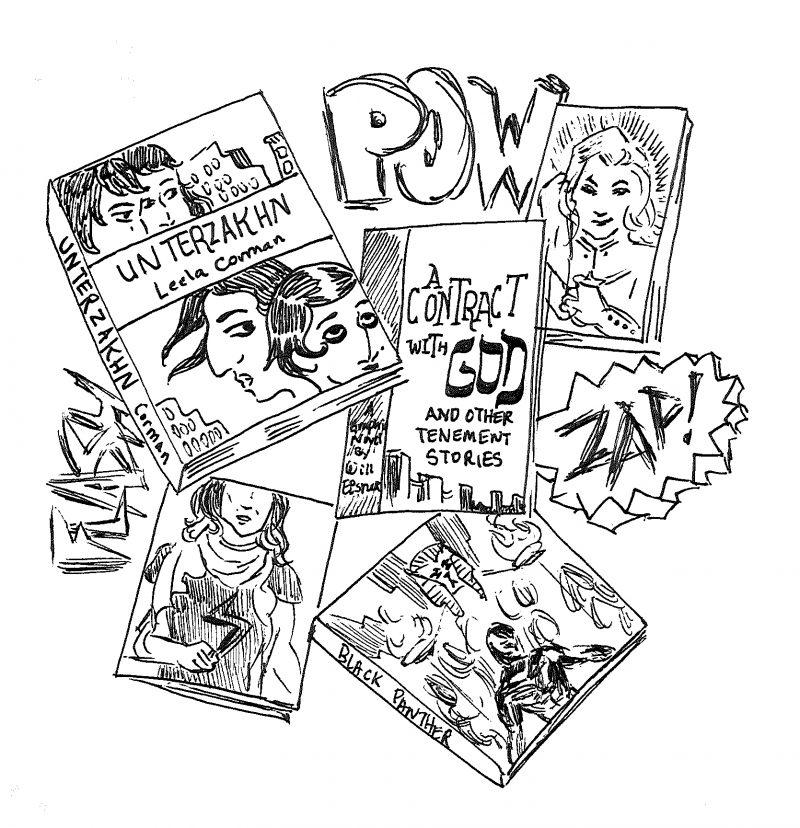A lot goes into the study of literature and of communication, and both involve studying how different media change and evolve over time, especially as expression moves beyond the written text. That’s why Trinity offers classes such as the Jewish graphic novel and the Marvel transmedia universe.
Victoria Aarons, professor of English, teaches a class on the Jewish graphic novel that was brought into existence at the request of students in her Holocaust literature class. The latter course covered, among other things, Art Spiegelman’s “Maus,” which was the first graphic novel to win a Pulitzer Prize and led a high number of other Holocaust survivors to tell their stories through the graphic novel.
“[‘Maus’] raises a number of questions with Holocaust representation and the expression of art and atrocity and issues of genre,” Aarons said. “My students’ interest in Holocaust graphic novels made me think about Jewish graphic novels in general because Jews really kind of invented the comic strip in the United States and certainly the graphic novel, with someone like Will Eisner, one of the pioneers, if not the pioneering graphic novelist. In fact, Will Eisner coined the term ‘graphic novel.’ ”
While describing how she begins the class with Eisner, Aarons emphasized the role of Jewish people in establishing comics in American culture, citing superheroes, such as Superman, as an example of the early Jewish American cartoonists using the medium to respond to the issues of Nazism, modern diaspora and the expression of Jewish myth, as manifested by the presence of the golem.
“A graphic novel is a sequential unfolding hybrid genre, and what’s so interesting about the graphic novel is its hybridity,” Aarons said, talking about how cartoons have always had serious political history.
“I’m also looking at some graphic adaptations of works of fiction,” Aarons said. “For example, we’re reading Kafka’s ‘The Metamorphosis.’ Kafka who is of course a major Jewish novelist, but also the beginning of modernist fiction in general. So we’re reading ‘The Metamorphosis’ but also, we’re reading Peter Kuper‘s graphic adaptation of ‘The Metamorphosis’ because one of the questions I want to ask is ‘what’s gained in the graphic form, this hybrid form, and what’s lost?’ ”
Jennifer Henderson, communication professor, teaches the Marvel transmedia universe class, which was brought about from Henderson’s background in teaching the intersection between fandom and storytelling that extends beyond a particular medium.
“The course is divided into three foundational areas, just like the Department of Communication, and so we’re studying the industrial structure of Marvel and how it’s obviously owned by Disney and how that conglomeration and those choices are influencing the transmedia story,” Henderson said, describing the organization of the class. “We’re looking at the texts themselves, and investigating the movies, comic books and novelizations of Marvel. And then we’re looking at the audiences as well, and so how fans are behaving with this transmedia universe.”
Henderson talked about her rationale for focusing on Marvel in particular, noting the efforts to connect the canon across media, as well as students’ interest in exploring this universe with which they grew up. In Henderson’s eyes, Marvel’s familiarity gives students who are less familiar with comics a chance to discuss media.
“One of the basic foundations of studying transmedia storytelling is that you’re supposed to use the medium that fits that portion of the story best,” Henderson said while discussing how studying the intersection of comics and other media should be approached.
Aaron Delwiche, professor of communication, has a background in studying and teaching comics and other media and has taught classes at Trinity concerning comics’ effects and reflections on American culture.
“The fact that we are even able to teach comics in an academic setting in higher education is pretty remarkable, and it’s partly because of a handful of books that came out in the 1980s that were seen as completely legitimizing the medium,” Delwiche said.
Delwiche referenced graphic novels like the aforementioned “Maus” by Art Spiegelman, “Watchmen” by Alan Moore and “The Dark Knight,” a Batman anthology, as examples that indicate a maturity in the industry. Delwiche’s hope in classes that focus on comics and graphic novels is that people with and without experience in engaging comics can participate in the prevailing discourse freely.
Students interested in investigating and thinking critically about comics as a whole can email the corresponding professors of these classes. Given that Aarons’ classes invite students to try their hand at the form and Henderson especially emphasizes producing works of formal scholarship on the subject, students should be excited to see what they can contribute to the study and practice of comics and graphic narrative.







